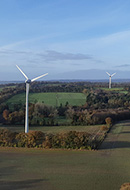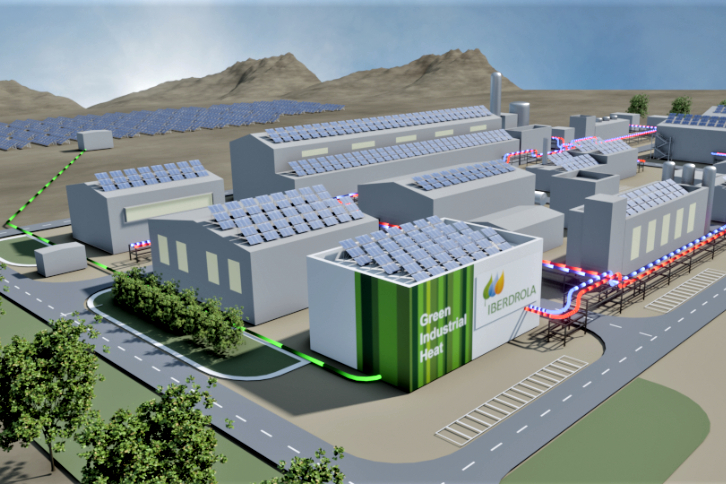Eletrificação industrial
A eletrificação da indústria por meio de energias renováveis
P+D+I Eficiência energética Descarbonização
A descarbonização da indústria por meio da eletrificação é essencial para combater as mudanças climáticas, consumir a energia de forma mais eficiente e promover a inovação. Trata-se de uma etapa crucial no caminho para um futuro mais sustentável e resiliente. A seguir, analisamos quais são as melhores alternativas para alcançar esse objetivo, avaliando suas diferentes opções.
Uma grande parte da demanda energética da indústria provém do chamado calor industrial, aquele utilizado nos processos relacionados com essa atividade. O calor é indispensável para uma ampla gama de aplicações industriais: aquecimento de fluidos, geração de vapor, realização de reações químicas, secagem de materiais, fusão de metais ou aquecimento de instalações. Além disso, devido a sua grande variedade de usos, o calor industrial geralmente requer diferentes níveis de temperatura e quantidades de calor, conforme as exigências específicas de cada processo.
Historicamente, os combustíveis fósseis, como gás natural, petróleo e carvão, têm sido usados para gerar esse calor em caldeiras e fornos industriais. No entanto, com o crescente interesse pela sustentabilidade e a busca pela redução das emissões de gases de efeito estufa, o setor está buscando cada vez mais fontes de calor renováveis e com maior eficiência energética. Não há dúvida de que a eletrificação da demanda industrial é um elemento essencial para avançar rumo a um modelo energético mais sustentável. A eletrificação permite um uso mais eficiente da energia, ao mesmo tempo em que possibilita a implementação de tecnologias de controle e monitoramento mais avançadas, o que resulta em uma gestão mais precisa e eficiente dos processos industriais.
Se quiser saber mais sobre a “revolução do século XXI”, descubra as vantagens da eletrificação e como a Iberdrola pretende se tornar um aliado no caminho da eletrificação industrial rumo a um futuro energético mais limpo, responsável e inteligente.

Eletrificação
Descubra por que é fundamental para combater as mudanças climáticas.

ETaaS
Seu aliado no caminho para a eletrificação industrial.

Descarbonização
Princípios e ações regulatórias para combater as mudanças climáticas.

Rede de calor
Inovação na gestão térmica para um futuro sustentável.
Alternativas renováveis de calor industrial para eletrificar e descarbonizar a indústria
Dada a necessidade de diferentes níveis de calor, existem várias alternativas para fornecer calor industrial ecológico que ajudam a reduzir as emissões e a dependência da indústria dos combustíveis fósseis. Portanto, dependendo da temperatura desejada, as melhores opções serão diferentes.
Altas temperaturas de mais de 500º C
No caso de altas temperaturas, os fornos elétricos estão disponíveis para muitas aplicações. Em outros casos, quando isso não é possível, o biometano ou o hidrogênio verde são as melhores opções. O biometano é uma forma de metano, sendo o principal componente do gás natural, mas sua produção vem de recursos renováveis, e não de fontes fósseis. Portanto, onde houver recursos adequados e uma infraestrutura de gás natural estabelecida, o biometano pode ser uma opção interessante e sustentável para o calor industrial, embora sua disponibilidade seja limitada.
O hidrogênio verde, produzido a partir de fontes de energia renováveis, pode ser usado como combustível em caldeiras e fornos industriais, substituindo os combustíveis fósseis tradicionais. Esse tipo de hidrogênio apresenta uma alta densidade de energia e pode ser armazenado e transportado, o que permite uma maior flexibilidade na distribuição e utilização do calor. No entanto, é importante destacar que a produção em larga escala de hidrogênio verde requer uma maior disponibilidade de energia renovável e uma infraestrutura adequada para sua produção e distribuição.
Altas temperaturas de mais de 500º C
- Biometano
- Hidrogênio verde
- Instalação renovável

Para temperaturas médias e altas, entre 100°C e 500°C
Essa é a maior variedade de opções renováveis de calor industrial para favorecer a descarbonização e a eletrificação da indústria. Uma delas é a biomassa, através de diferentes formas como cavacos de madeira, resíduos agrícolas e florestais locais, resíduos da indústria alimentícia ou biogás, que contém principalmente metano e, como os anteriores, também pode ser usado como combustível em caldeiras para gerar calor industrial. Suas principais vantagens incluem o fato de usar resíduos renováveis que, de outra forma, seriam descartados, o que contribui para a redução de resíduos e emissões, e o de ser uma fonte de energia local, o que pode reduzir a dependência de combustíveis fósseis importados.
Outra solução são as caldeiras elétricas que, em vez de queimar combustíveis fósseis, como gás natural ou óleo, usam resistências elétricas para converter em calor a energia elétrica obtida de fontes renováveis. Suas principais características são a alta eficiência energética em comparação com as caldeiras de combustão, nenhuma emissão direta de gases poluentes ou dióxido de carbono durante a operação e controle preciso da temperatura, o que pode ser benéfico em processos em que é necessário um controle rigoroso da temperatura.
Nos casos em que são necessárias temperaturas médias e altas, outra opção pode ser o armazenamento térmico. Essa tecnologia possibilita o armazenamento de energia gerada por fontes renováveis e o uso desse calor gerado em processos industriais em momentos em que ele não é necessário de forma imediata. Existem diferentes métodos de armazenamento térmico usados no calor industrial:
- Armazenamento de calor sensível: é usado um meio ou material que pode reter e liberar calor em função das mudanças de temperatura. Os mais usados são pedras, tijolos, sais fundidos ou outros materiais de mudança de fase.
- Armazenamento de calor latente: o calor é armazenado em um material que muda de fase durante o processo de carga e descarga térmica e, quando muda de estado, por exemplo, de sólido para líquido ou de líquido para gás, ele absorve ou libera uma grande quantidade de calor latente. Alguns exemplos são os sais, as parafinas ou os materiais orgânicos de mudança de fase.
- Armazenamento de calor químico: neste caso, o armazenamento ocorre por meio de uma reação química que absorve ou libera energia térmica. São usados materiais químicos que podem se decompor ou reagir quimicamente para armazenar ou liberar calor. Podemos citar como exemplos o uso de hidretos metálicos ou reações endotérmicas e exotérmicas.
Uma das principais vantagens do armazenamento térmico é que a energia térmica pode ser gerenciada de forma eficiente, pois o calor pode ser armazenado durante períodos de baixa demanda e usado em períodos de alta demanda, otimizando assim o uso de fontes de energia renováveis intermitentes, como a energia solar ou eólica. Além disso, ele pode melhorar a flexibilidade e a estabilidade dos sistemas elétricos, pois funciona como uma bateria térmica, aproveitando o excedente de energias renováveis e mitigando perdas, o que facilita uma maior entrada de energias renováveis no sistema.
Para temperaturas médias e altas, entre 100°C e 500°C
- Biomassa
- Armazenamento térmico
- Caldeiras elétricas
- Instalação renovável

Para temperaturas baixas, inferiores a 100°C
Quando se busca uma alternativa renovável para calor industrial em baixas temperaturas que ajude a descarbonização da indústria, as aerotermia e as bombas de calor são as mais indicadas A aerotermia usa o ar ambiente como fonte de energia para gerar calor por meio do uso de bombas de calor. Essas bombas de calor extraem o calor do ar, mesmo em baixas temperaturas, e o transferem para um sistema de aquecimento ou de água quente para uso em aplicações industriais. Isso faz com que sejam mais eficientes em termos de energia em comparação com as tecnologias de aquecimento convencionais. Para cada unidade de energia elétrica consumida, uma bomba de calor pode gerar várias unidades de energia térmica.
Além disso, a aerotermia e as bombas de calor não geram emissões diretas de gases de efeito estufa durante a operação e são muito versáteis, podendo ser usadas para aquecimento industrial, processos específicos na indústria ou sistemas de climatização em combinação com unidades de refrigeração, o que proporciona maior flexibilidade na regulação da temperatura em diferentes processos. Também não requerem uma área específica para armazenar combustíveis ou instalar equipamentos de combustão.
Baixas temperaturas, inferiores a 100°C
- Aerotermia
- Bombas de calor

 VER INFOGRÁFICO: Alternativas renováveis de calor industrial para descarbonizar a indústria
VER INFOGRÁFICO: Alternativas renováveis de calor industrial para descarbonizar a indústria
O que são redes de calor?
As redes de calor que reutilizam o calor excedente de um processo de produção para um segundo uso são conhecidas como redes de calor de recuperação ou redes de calor de processo. Essas redes aproveitam o excesso de calor gerado em atividades industriais e o canalizam para usos adicionais, como, por exemplo, para cobrir as necessidades de aquecimento em edifícios próximos. Dessa forma, existe um maior aproveitamento da eficiência ao evitar que o calor seja desperdiçado e dissipado no ambiente, reduzindo assim a demanda adicional de energia e, consequentemente, as emissões de carbono. No entanto, para que esse tipo de rede seja eficaz, é necessário que os processos industriais ou os edifícios nos quais ele será usado estejam próximos. Dessa forma, o calor residual pode ser transferido para os pontos de uso com eficiência por meio de uma rede de tubulações.
Portanto, tratase de uma maneira eficaz de aproveitar a energia residual dos processos industriais e reduzir seu impacto ambiental. Essas redes elevam a eficiência energética, oferecem benefícios econômicos e contribuem para a transição rumo a um modelo mais sustentável.





